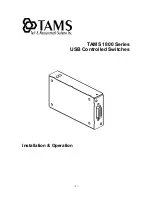
40
Appendix A: Router Configuration
The following section describes the initial configuration of the router and port
forwarding for your router. If your router is not listed here, please refer to the
manufacturer’s website for assistance with configuring your router to work with IP
Switch.
Port Forwarding for IP Switch
IP Switch requires certain ports to be open on your router to allow other computers
on the Internet to view it on your internal network. Normally, your router will have the
less common ports disabled or blocked by the router’s built-in firewall. In order for IP
Switch applications to work properly and not be blocked, the firewall settings need to
be configured. In each instance there will be a trigger port and incoming port(s),
where traffic on the trigger port tells the Firewall to open the incoming ports. IP
Switch requires that TCP Port 80 (default settings) be opened to the Internet. TCP
Port 80 is used for accessing the IP Switch homepage.
Change to other port if your Internet service Provider blocks port 80.
Below are some examples of setups, you should refer to your Router’s User manual
or contact your router manufacturer for assistance in configuring the router.
D-Link (http://www.dlink.com)
DI-604/DI – 614+/DI-624
1. Log into your router using your router IP.
2. On the main page, click on
Advanced
at the top of the page.
3. On the left side of the page, click on
Virtual Server
. Note: Make sure DMZ host is
disabled. If DMZ is enabled, it will disable all Virtual Server entries.
4. Enter the following information on the page:
Enable/Disable:
Enabled
Name:
IP Switch - Webpage
Private IP:
Type in the
UIS LAN IP address
, for example: 192.168.0.5
Protocol Type:
TCP
Private Port:
80
Public Port:
80
Schedule:
Always
5. Click
Apply
to save the settings. IP Switch should now be configured to work with
your router and be accessible from the Internet.











































